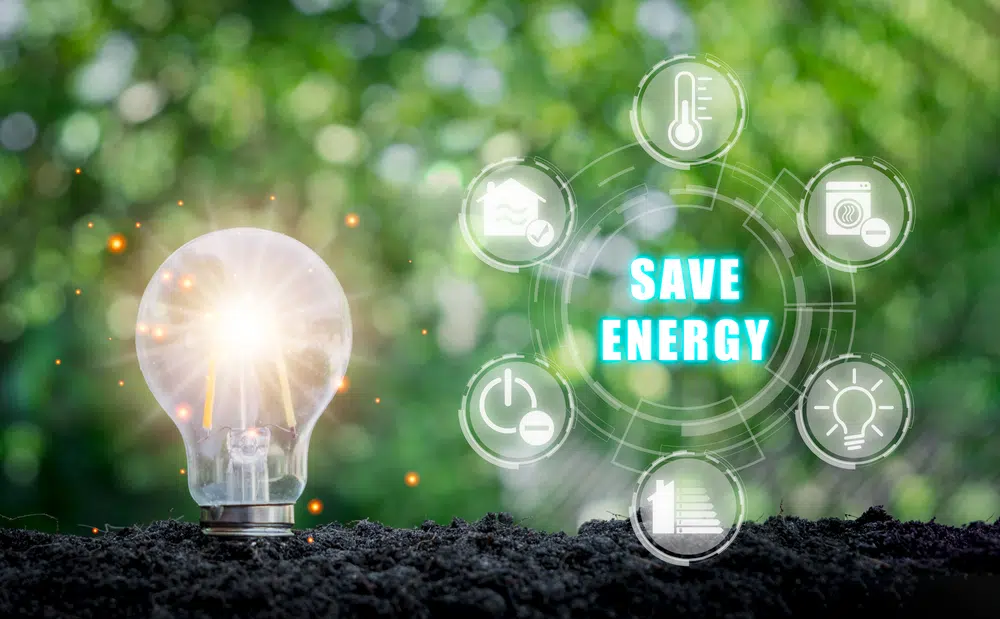Saving energy at home helps to minimize harmful emissions and global warming, in addition to significantly reducing electricity costs. Many homes use energy inefficiently through the overheating and undercooling of spaces, inadequately insulated windows and doors, and excessive use of household appliances. Careful management of energy use ensures preservation of comfort while producing usable energy.
Important actions such as changing light bulbs or installing air conditioning systems with better controls and monitoring can result in great benefits. Making energy-aware selections promotes sustainability without a significant impact on your home’s efficiency. With well-documented steps on energy consumption, energy conservation measures can be designed with ease. This article presents numerous ways of improving efficiency to reduce energy consumption in the home.
Replace Spent Appliances with Energy-Efficient Appliances:
One of the easiest ways to reduce electricity usage is switching to energy-efficient appliances. Newer appliances with Energy Star ratings are designed to use less power than older models while still delivering the same or better performance. Refrigerators, washing machines, and dishwashers are now more energy-efficient than ever compared to older models and are significantly cheaper to operate. Although there may be a higher upfront cost on utility bills, these appliances will provide amazing long-term savings. Look for features such as programmable settings, automatic shut-off, and low-energy consumption modes. These small tweaks can be made with minimal effort and aid greatly in reducing overall energy expenses.
Heating and Cooling System Optimization:
Out of all household activities, heating and cooling take up the most energy. To optimize energy waste, ensure your HVAC system is regularly maintained and running efficiently by changing the filters. Insulating the walls, floors, and ceilings of a home can significantly reduce the loss of heat in winter and the retention of cool air in summer. Caulking gaps around doors and windows helps seal cold drafts and improves the overall efficiency of heating and cooling. Programmable thermostats allow users to set schedules that automatically adjust temperatures when a home is occupied, which helps save energy. The use of ceiling fans greatly assists in the distribution of air and can reduce the workload on heating and cooling systems.
Enhance Insulation:
A well-insulated home will save energy while maintaining a comfortable temperature. Installing insulation in your home’s attics, walls, and floors minimizes heat loss in winter and heat gain in summer. Additionally, double-glazed windows aid in restricting indoor temperature fluctuations because of heat transfer. Weather stripping around the windows and doors prevents air leaks, leading to temperature inconsistencies. Investing in high-quality insulation increases energy efficiency and reduces the demand on heating and cooling systems. This will, in turn, reduce energy expenditure and costs. Insulation that is properly done only once will help achieve long-term savings and comfort.
Switch to LED Lights:
Lighting is one of the major contributors to the energy consumed in a household. Replacing traditional incandescent bulbs with LED lights will reduce electricity consumption. LED bulbs last longer and use up to 75 percent less energy, leading to increased cost-effectiveness. Smart lighting systems increase energy efficiency since you can adjust the brightness and set the lights on schedules. During the day, you should also maximize the use of natural light by keeping windows clean and using lighter-colored curtains that reflect sunlight. Upgrading to LED changes the overall illumination of your house while helping you save money and increasing energy efficiency.
Embrace Smart Home Technology:
Smart home devices provide an effective method to control and monitor energy consumption. Today’s smart devices offer automated energy consumption. For example, smart thermostats regulate temperatures dynamically according to your daily routine, ensuring energy is optimally used at all times. Additionally, smart plugs and power strips prevent phantom energy loss by automatically cutting power to idle devices.
Likewise, motion sensor lighting helps in cutting down electricity that is not needed by instantly turning lights on and off when necessary. Enabling real-time insights into energy consumption, smart meters provide homeowners with vital data in real time, allowing them to make informed decisions regarding energy usage. In addition to these technologies enhancing ease of use, they also promote the adoption of smart energy-saving habits.
Minimize Water Use:
Water heating contributes to a large percentage of energy bills. The installation of low-flow showerheads and faucets helps cut down the consumption of water without affecting pressure. Removing the need to heat water and using cold water during laundry helps conserve energy. Promptly fixing all kinds of leaks helps conserve water and, as a result, leads to bill reductions.
Pipes and water heaters can have their insulation boosted, maintaining temperature for longer and cutting down the amount of energy used. Simple steps can also be used to collect rainwater for outdoor use, and efficient irrigation systems can be utilized to cut down on the excessive use of water. These simple steps cut down on the usage of water as well as the energy required to be used to heat it, leading to significant cost reductions.
Refrain From Using Devices That Require an Excess of Power:
Phantom energy drain may seem like a thing of the past, but it continues to persist today. It refers to the consumption of energy that happens when devices are in standby or off mode. By a device’s charger, TV, and appliances actively removing energy is a step to combat phantom energy drain. Devices that need to be charged should only be plugged in when they are ready to be upgraded to a new charging level. Since electronic devices such as ovens, microwaves, and coffee machines consume energy when plugged in, remember to switch them off using a multi-plug. Empowered consumers who actively work towards minimizing power drain can decrease BIMBOs while maximizing energy efficiency.
Adopt Energy-Saving Measures:
Doing things such as setting the house temperature using air conditioning or opening windows when the season of fall/winter arrives can make a drastic reduction in energy spent. Such simple things as going to turn on energy-saving lights while leaving the room should be turned off. Ditching the use of a dryer in favor of using one is helpful as well.
Putting lids on pots reduces the amount of energy spent when something is being cooked, as it decreases the amount of heat that escapes. Dishing out meals in a set and using the microwave to reheat for the next serving should be the gold standard in terms of energy use. Additionally, allowing wind to do what it does without the use of AC ensures that energy consumption is kept at a bare minimum.
Conclusion:
While the concept of making your home energy efficient can seem daunting, adopting a step-by-step approach makes the task easier. Upgrading your appliances, improving your home’s insulation, and using smart technology to manage heating and cooling can significantly reduce energy waste. Furthermore, switching to LED lights, conserving water, and unplugging unused devices also play an important role in achieving energy efficiency in the home. These habit changes reward the individual by reducing long-term costs over time and earning benefits environmentally. As the cost of energy goes up, by employing even the basic energy hacks, the individual will not only save money but also advance the effort towards sustainability. Ensuring energy usage is dealt with more mindfully means making an effort to manage waste while enhancing comfort and convenience that can be maintained at home.
FAQs:
1. How can I single-handedly reduce my electricity bill without big renovations?
Changing to LED lights, unplugging devices that are not in use, using smart thermostats, managing air conditioning, and controlling the heating are all simple practices that do not require extensive renovations.
2. Is employing smart gadgets in the home worth spending on?
Definitely. Home automation like smart plug-in devices, motion sensor lights, or smart thermostats goes a long way towards making energy-saving automation possible, which reduces electricity sold over time alongside other expenses.
3. In what ways does insulation impact energy efficiency?
Effective insulation helps to retain warmth in a home during winter and keeps it cool during summer. It, therefore, reduces the need for cooling and heating the house, which in turn improves energy consumption and efficiency of the home.
4. What tips can you give on conserving water at home?
Some water conservation methods include the use of low-flow toilets and shower heads, faucet and toilet leak repairs, cleansing clothing with cold water, insulating the water heater, and gathering rainwater for other outdoor uses.
5. Is unplugging appliances really helpful in saving energy?
Yes, many devices use phantom power when switched off. This can be avoided by unplugging appliances or using power strips to cut off power completely, which greatly reduces standby energy losses, lowers electricity bills, and reduces phantom energy loss.

